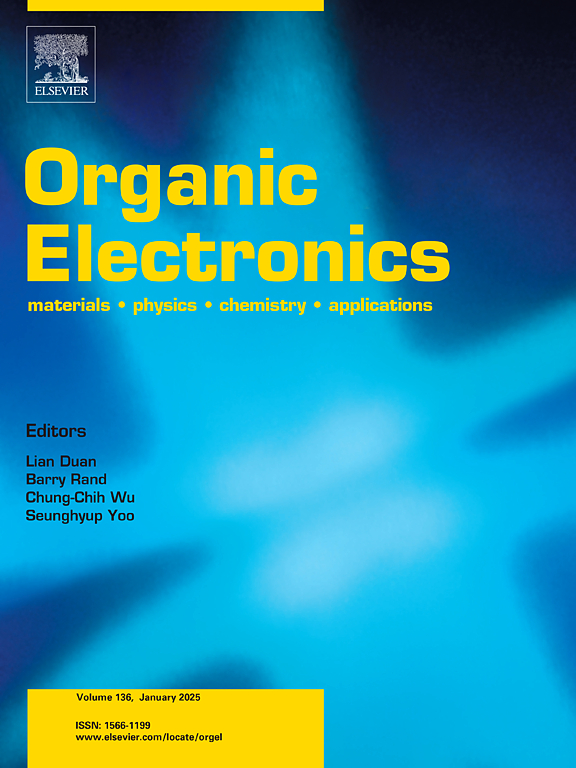Selection of compatible blended cohost towards boosting performance of TADF-polymer light-emitting electrochemical cells
IF 2.6
4区 工程技术
Q3 MATERIALS SCIENCE, MULTIDISCIPLINARY
引用次数: 0
Abstract
Light-emitting electrochemical cells (LECs) using thermally activated delayed fluorescent (TADF) polymer emitter are attractive since they own the great potential in fabricating robust LECs with low-cost and high efficiencies towards various applications. However, current scarce study disclosed that it is hard to simultaneous optimize electrochemical doping and multi-component miscibility of the emissive layer, which renders luminance and external quantum efficiency (EQE) of TADF-polymer LECs still quite low, e.g. less than 500 cd m−2 and 1.0 %. Here, we propose to select compatible p-type and n-type small molecules as cohost of TADF-polymer emitter, which is critical to simultaneously achieve balanced, efficient p-/n-type electrochemical doping and charge transport, efficient energy transfer from cohost to TADF-polymer emitter and most importantly well restrained intra- and inter-molecular interactions, i.e. self-aggregation of host and redshift effect of host on TADF-polymer emitter. TADF-polymer LEC using such a qualified compatible cohost achieved a peak luminance of 1292 cd m−2, a peak EQE of 2.24 %, and a peak luminous efficiency of 6.89 cd A−1 at 6.5 V, which is distinctly superior to that of control devices and earlier report of TADF-polymer LECs. It proves the effectiveness of such strategy and provides a research thought on further developments.

选择相容混合共宿主提高tadf -聚合物发光电化学电池的性能
利用热激活延迟荧光(TADF)聚合物发射极的发光电化学电池(LECs)具有制造低成本、高效率、坚固耐用的LECs的巨大潜力,具有广泛的应用前景。然而,目前缺乏的研究表明,很难同时优化电化学掺杂和发射层的多组分混相,这使得tadf聚合物LECs的亮度和外量子效率(EQE)仍然很低,例如小于500 cd m−2和1.0%。本文提出选择兼容的p型和n型小分子作为tadf -聚合物发射极的共宿主,这对于同时实现平衡、高效的p /n型电化学掺杂和电荷输运、有效的从共宿主到tadf -聚合物发射极的能量传递,以及良好地抑制分子内和分子间的相互作用,即宿主的自聚集和宿主对tadf -聚合物发射极的红移效应至关重要。使用这种合格的兼容共宿主的TADF-polymer LEC在6.5 V下的峰值亮度为1292 cd m−2,峰值EQE为2.24%,峰值发光效率为6.89 cd a−1,明显优于控制器件和先前报道的TADF-polymer LEC。证明了该策略的有效性,并为进一步发展提供了研究思路。
本文章由计算机程序翻译,如有差异,请以英文原文为准。
求助全文
约1分钟内获得全文
求助全文
来源期刊

Organic Electronics
工程技术-材料科学:综合
CiteScore
6.60
自引率
6.20%
发文量
238
审稿时长
44 days
期刊介绍:
Organic Electronics is a journal whose primary interdisciplinary focus is on materials and phenomena related to organic devices such as light emitting diodes, thin film transistors, photovoltaic cells, sensors, memories, etc.
Papers suitable for publication in this journal cover such topics as photoconductive and electronic properties of organic materials, thin film structures and characterization in the context of organic devices, charge and exciton transport, organic electronic and optoelectronic devices.
 求助内容:
求助内容: 应助结果提醒方式:
应助结果提醒方式:


